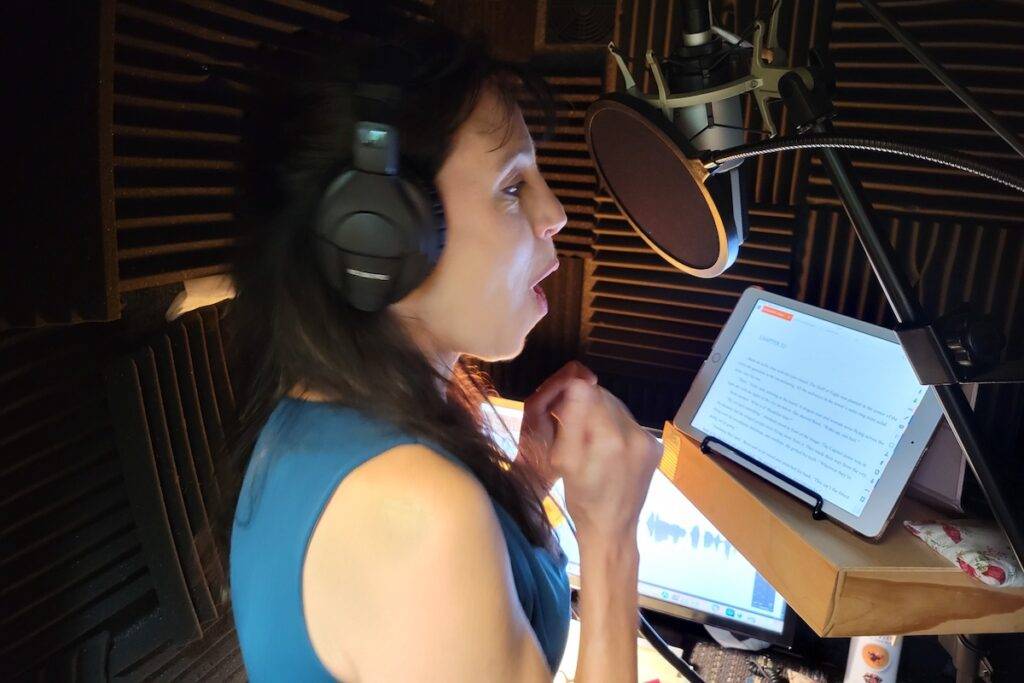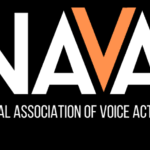I play a lot of characters and I mean a LOT. For me, getting into the mind of every kind of person is both satisfying and illuminating. I love capturing both the hero and the villain, the mom and the sword maven, the dog and the cat — you get the idea! But diving into each one of these personalities means significantly changing the way I speak for every character. Some of that is functional: because a single-narrator audiobook only has one speaker, you need a way of telling who’s who (as opposed to full cast where this is less of an issue). But it’s really a lot more than that. Whether I’m playing a man, a chipmunk, or an old lady, I’ve learned to adjust my voice to suit.

Why I adjust my voice for the character
Believe it or not, there was a time in the Audiobook world where many people didn’t do this. It was once commonplace to pick a “neutral” accent and read the book straight through, with light, subtle shifts from person to person (the incredible Barbara Rosenblatt being a trail-blazing exception!). But it’s waaaay more fun to really inhabit a passel full of different beings!
So, when I do a first readthrough, I note new characters, what the author writes in their description of them, how other characters talk to and about them, and any additional ideas that leap to mind in my reading as a “consumer” — do they remind me of someone I know? A character in a film? An animal? I think about their accents and pitch, their demographic characteristics, and even any subtle speech idiosyncrasies! Other things I ponder: What’s their upbringing or class? What influences might they have had during the formative language years that would make this person’s speaking style totally unique to them?
All of this is to say, we enjoy books more because we’re totally immersed in them, and that’s as a result of the characters. Bringing forth these personalities through their speech patterns just takes it a step further and allows the audience to get to know the people in the book in a whole new way.
How I adjust my voice for my characters
When starting out in the narration world, I had to rediscover a few things about my voice. Namely, how to adjust my pitch, register, tempo, vocal placement (this is HUGE), and timbre. It’s putting all these together differently for each character that gives them that personality. This is especially true for me, since I play a lot of men and have learned to successfully deepen my voice and/or bring in a timbre more closely associated with male voices. I think about pace and vocal placement, all the resonators, and even Laban technique. Many of the most successful narrators have experience playing with gender or as character actors and bring all that to the table.
What I do to enable these voice changes
Warming up should be a daily process, and I try to incorporate a few excercises as I go about my day. This could be while doing dishes or in the shower — it doesn’t have to be a standalone hours-long activity. In addition to the basics, I also dive in deeper if I know I have challenging vocal work ahead of me. For example, when I’m set to play a number of men in the next session in the booth, I might focus my energies on warming up my lower register. Alternatively, a day full of “chipmunking” will involve improving my female falsetto. For myself, I have learned that no matter how warm I am, I need “chew my face” breaks (really mobilizing and wriggling facial features), especially during a long recording session, when my face and jaw tighten up over time, limiting my expressibility.
What I do to change each aspect of my voice for the character
Register
You’re hopefully familiar with head voice and chest voice for singing. There are actually a few more registers, but we aren’t likely to use extreme ends for this (okay, yes, I do use them in epic fantasy or sci-fi sometimes!). For the most part, you speak in modal voice or chest voice, and that’s definitely a place to play around when thinking about a character. NOTE: be careful of placing characters on your break — it will exhaust your voice more quickly than characters above or below it!
Range
I’m separating this from register intentionally since you could be in one register but a different part of your range. Deepening and raising your voice is a surefire way to change age or gender. As a true alto, the low notes come naturally to me, but do NOT push yourself more than you’re ready for. Growing a range takes time, and my soprano range ALWAYS needs extra warm-ups, whereas below alto warm-up can be pretty minor.
Vocal placement
OK, so this is literally where you are placing your voice in your face. It’s a combo of mouth shape and resonators. For example, if I make my mouth really big on the inside, like I had an egg or a handball in there, that space can be moved backward, expanding the soft palate, or to the middle (tongue depressed in middle), or forwards (tongue pulled back). I can change the size of that space, creating a different sound (especially in the forward position). For any of these shapes, I can try to make it so the sound vibrates in my cheeks, my nose, my lips/teeth, my chest, the “top of the head” (not really a thing but the idea creates a different sound). You can also talk out of the side of your mouth, with your lower jaw protruding (great for goblins), with a relaxed or unusually placed tongue (creatures, some kids animation characters especially), or with tight/pursed lips. You’d be surprised at the differences!
Vocal Fry
Is fry still a thing? Should I do it? Yes, and I would recommend sparingly. Johns Hopkins says it won’t damage your voice. However, it CAN be a sign of a vocal disorder. It certainly has cultural connotations–both positive (especially as vocal fry is basically glottalization, prominent and normal in a bunch of languages) and negative.
That being said, vocal fry is certainly a way to distinguish a character!
Smoky Sound
Smoky sound is different from vocal fry — smoky sound (also called whisky voice!) can be in ANY register, can be less breathy, and can be increased or decreased. My natural speaking voice is pretty smoky, even though I have never smoked, and although that sound is a very easy, relaxed narration place for me, I “clean it” or “dirty it” to help distinguish between characters. When added to other choices (vocal placement, register, etc) it can make a huge difference, even if the adjustments are small. Listeners love it, especially if the character is sexy!
Slight Burr
I don’t see people talk much about a burr any more, so here’s my take: a non-breathy, any-register purry-growl sound that can be turned up or down and runs like a current under most of the character’s dialogue. I find it to be tiring and requiring a lot of concentration, so I use it with care. Characters that I know will be killed off often get the burr!
As always, have fun! If it’s not fun, it will be harder to accurately recapture the voice, and the slight negative feeling you have can transfer over in super subtle ways that impact how the reader feels when they listen. Save the hardest or least fun vocalizations for characters no one is supposed to like, and in general, remember that fun in the booth makes the process and the product better for everyone!





